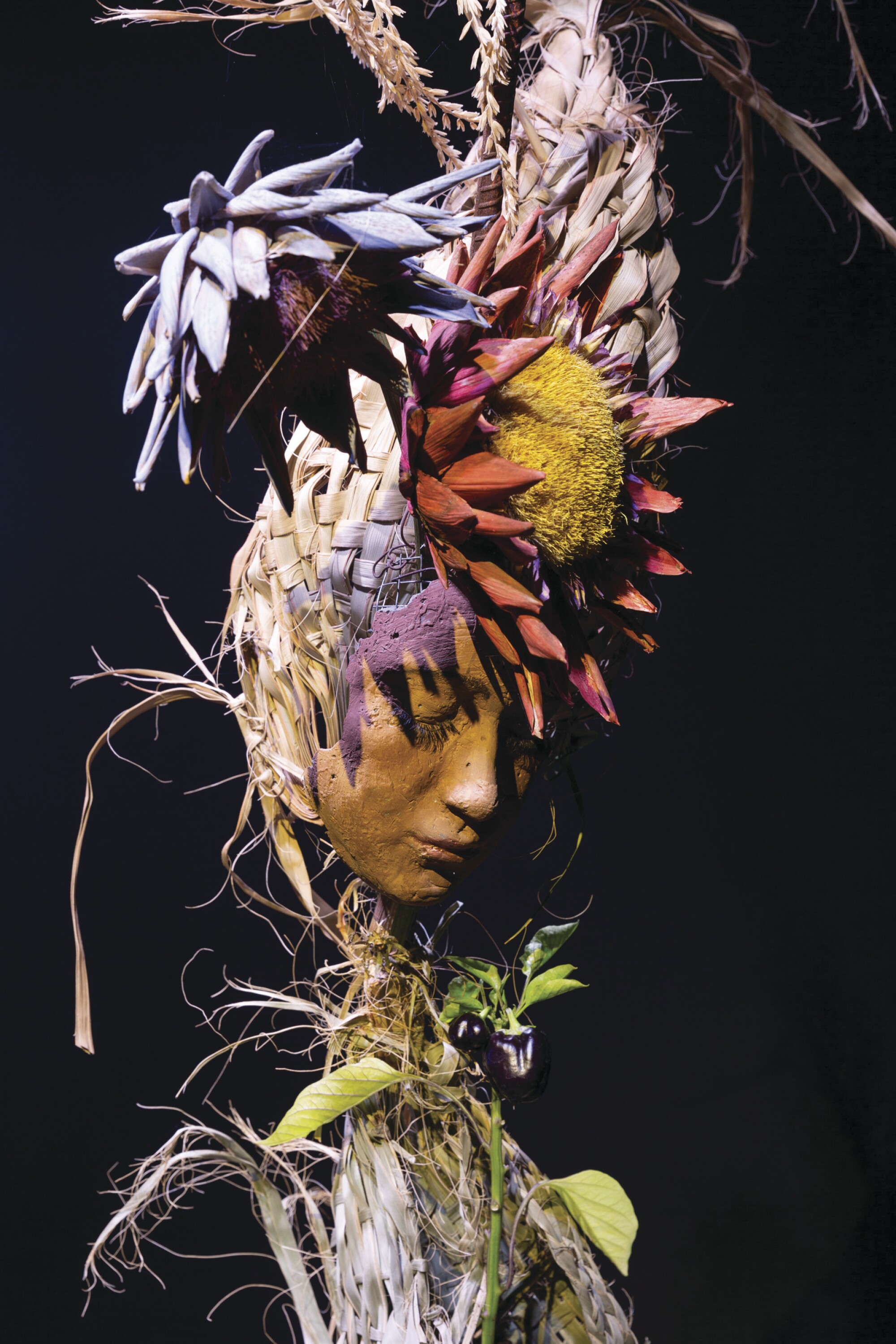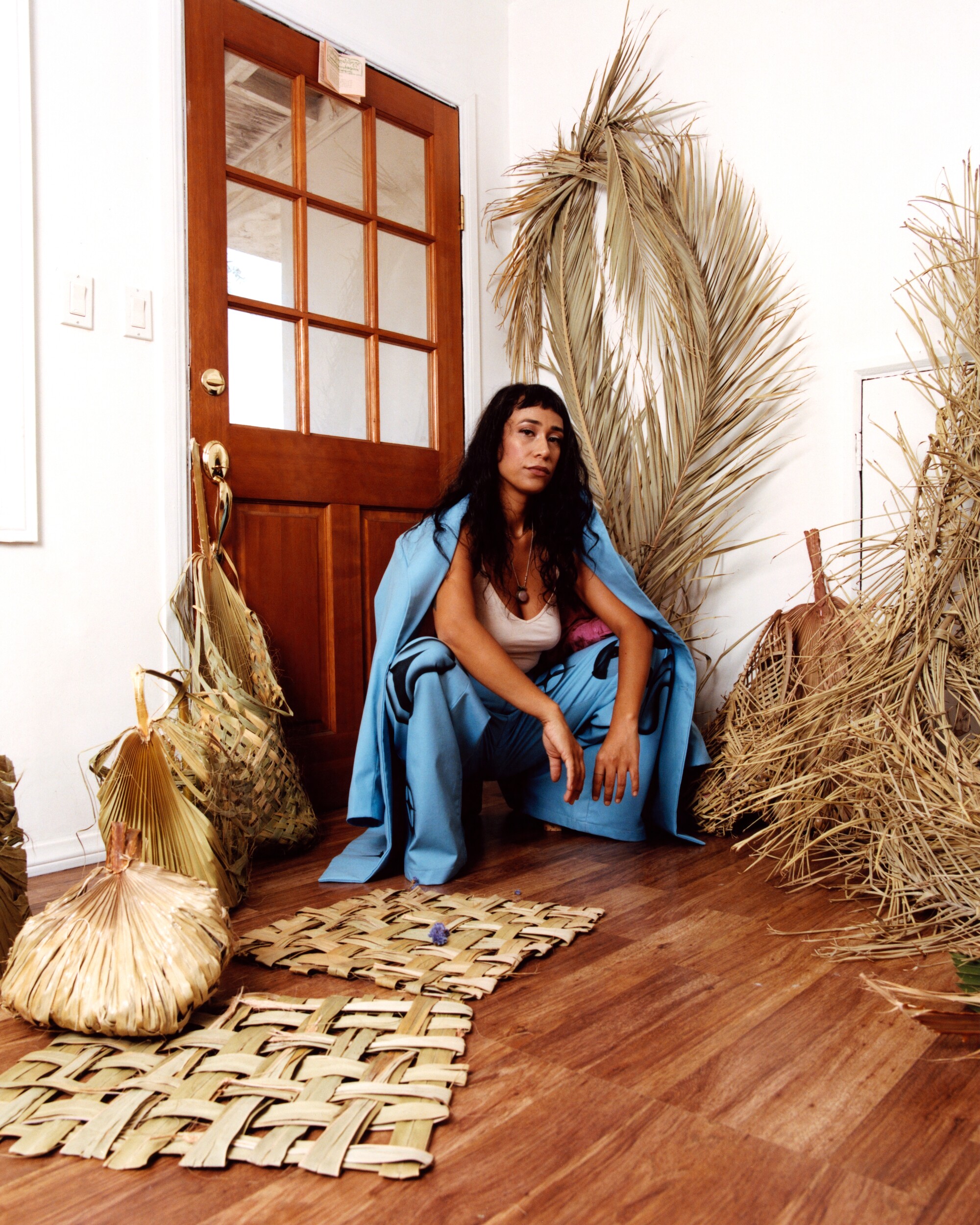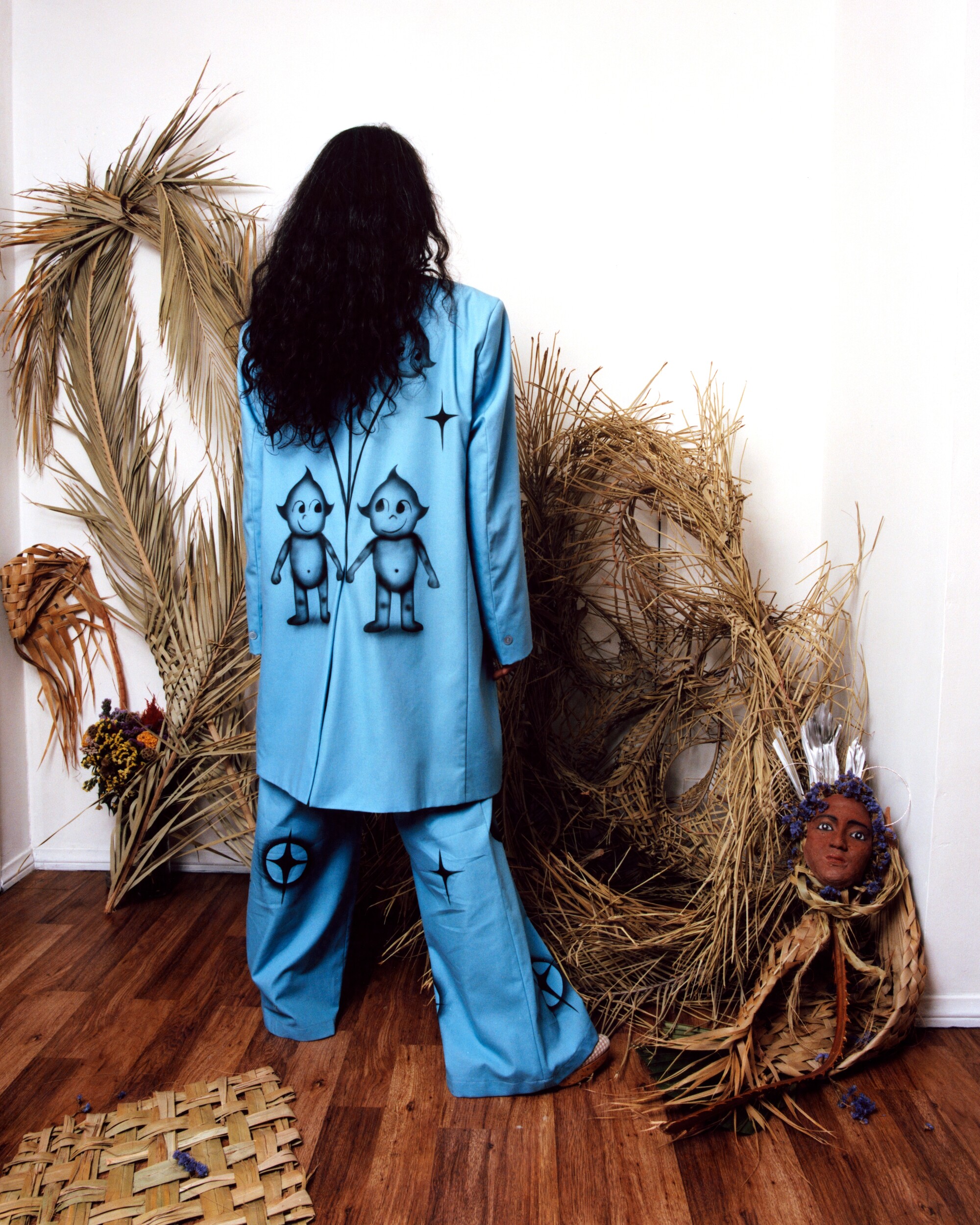When making art, “I’m not trying to construct a figure,” as one artist put it.

This story is part of Image issue 12, “Commitment (The Woo Woo Issue),” where we explore why Los Angeles is the land of true believers. Read the whole issue here.)
The mask of a human face emerges cactus-like from a pot. An open hand made of corn husks — a mano poderosa — fans open, its parts held together by the resilient weave of palms. A weightless figure made from twigs, dried plants and fruits rests over a stationary bike. Maria Maea’s artworks are, as she’s described them, “altars” of objects she’s collected and lived with over long periods of time. The masks — a recurring image — often are molds of family members. Each work holds a specific memory. At times, she doesn’t even realize she is making an art piece until after the fact: The objects live “in such a space of my prayer, my meditations, that sometimes I don’t always zoom out and really see the entirety of something.”
In this conversation, artist rafa esparza speaks with Maea, a friend and collaborator, about the spiritual and deeply personal act of creating objects and the forces that lead her to make them.
“I feel like, in many ways, our family is one of our earliest communities,” says artist rafa esparza.
(Gabriel S. Lopez/For The Times)
rafa esparza: I wanted to start by asking you how you came to have a relationship to art or creativity. I‘d like for this to be an opportunity for us to think about how we use art and how we relate to art, but also how art exists in our families and our cosmologies. When did you start to know that you wanted to make things, make art?
Maria Maea: I come from a very large family, where resource was spread between a lot of people. So, to have a birthday cake was a creative process — that was artistic. I remember we couldn’t afford Christmas trees, and my mom would go and get butcher paper from the church and cut a tree out. And then we’d draw ornaments on paper. It allowed us this ability to feel like we were engaged, creatively with one another and with ourselves. You know, we were a family who all shared a coloring book!
For a really long time as a young person I didn’t have the resources to say, “I can get a fancy notebook; I can get these really nice colored pencils.” I felt like, I can’t make art and I can’t be an artist. But I think a lot through the desire to be a part of something. Being a teenager and meeting other young brown creative people who were playing music in Long Beach, who were trying to do whatever they could to just enjoy their lives, I found community there, I found agency there.

“I see so many of us, and that’s been actually comforting me to do the work of being in communication with a deeper ancestor,” says artist Maria Maea.
(Gabriel S. Lopez)
I didn’t go to school for art, but I would meet people out in the world. I’ve always been curious about what people’s capacities were, what they were working on. And I’ve always allowed myself to be bold in that way or open in that way.
re: You’ve alluded to this collective experience that you‘ve shared with your family. I feel like, in many ways, our family is one of our earliest communities, one of our first communities that we interact with before we have friends and start to socialize in these different spaces. Can you take a moment to just talk about who your family is and where it is that you come from?
MM: I’m a first-generation Mexican Samoan from Long Beach, Calif. My parents are both immigrants who migrated here — my mom from Samoa and my dad from Mexico, both when they were fairly young. I grew up between a lot of cultures discovering what it was to be here, discovering what it was to have an American dream.
I include my family in a lot of my work, because with such a large family, I feel like I have almost a case study of what migration is. As a Los Angeles person, as a person who has been able to gain resources and gain access to spaces that my family has just never seen or never participated in, and getting to use my family’s images through making casts of faces or using a mold of their hands, I get to bring them into these spaces with me that are sometimes really hard to stand in, and somehow, by bringing parts of them, I feel more capable.

Maria Maea, “Women’s Worth/Work” (2019-2020), Ribar, concrete, sunflowers, cactus and plants, 9 x 80 inches.
(Ian Byers-Gamber/Courtesy of Oxy Arts)
I do a lot of this kind of spiritual work, but sometimes I feel like I’ve been really afraid to call back, because I don’t know who’s there. I’ve been drawing these old photos of my family that I’m hyper-familiar with — pictures of my grandma, her sister, at my uncle’s funeral, a picture of my nino and my grandma, my cousin’s graduation picture. I start tracing out the shadows of their faces, and I see so many people’s faces along the way. Before I get to my nino‘s face, my brother shows up, my cousin shows — the angles, just the nuances of a nose, or the way an eye is shaped; I see so many of us, and that’s been actually comforting me to do the work of being in communication with a deeper ancestor. That level of familial knowledge gives you a sense of power and self-trust, allows you to navigate these things that exist right here.
re: Could you talk about the materials that you work with — because you’ve worked with a variety and in very distinct ways — how you combine them, how they’re activated sometimes in performances? You’ve molded ice, you’ve worked with clay and soil, you’ve been weaving palm fronds and you’ve also molded with wax. What’s your relationship to these materials, and how do you find them and how have they made their way into your work?
MM: I realized I’ve been creating these little prayer spaces for myself — these little altars of objects that resonate, like even as a young kid, when I had my dresser, my brother’s dresser and my other brother’s dresser. Our dresser tops were our art installations, right? They were the places where we got to identify ourselves: This is my dresser. I collected things that just resonated with me, whether it be this beautiful toy or a really cool marble I found on my walk home from school. My art practice still kind of exists in that way.
I think a lot of material collects around me in that way. Like, the discarded — I can walk down the street and find somebody’s rearview mirror that fell off, and I collect it and I bring it back and I set it in a space. I think of these objects as personifications, as having the capacity to be storytellers. In my space, a lot of things that I collect move around like gameboard pieces.

“These objects have an energy, and they have a relationship to each other and a story with each other. Sometimes with these sculptures, particularly the plant body ones, I don’t always feel like I’m building them,” says Maria Maea, pictured in a custom suit by Julissa Aaron. “A lot of the times I feel like they’re assembling themselves over time.”
(Gabriel S. Lopez / For The Times)
These objects have an energy, and they have a relationship to each other and a story with each other. Sometimes with these sculptures, particularly the plant body ones, I don’t always feel like I’m building them. A lot of the times I feel like they’re assembling themselves over time.
re: The ways in which you care for these materials, the ways you keep them and the ways that you work with them isn’t dissimilar to how you engage with people — at least for me, I feel like it’s been a very caring and supportive relationship that I’ve had with you.

“There’s a power to not switch up what we do for the sake of having a strong presence in the market,” says rafa esparza.
(Gabriel S. Lopez / For The Times)
What do you think happens to the objects as they live with you? What does it mean for them to inhabit the same space that you live in?
MM: I think the objects just kind of get embedded in my daily story — I’ll find this object and maybe it’ll be very representative of a moment in time for me, like a walk down the street, or a moment in the park with a friend or something like that. It’ll hold that memory for me, then it’ll sit in space, and those memories will kind of stay with the objects. Then, in placing them within a larger sculptural work or an altar space, they kind of get entangled into these other memories.
I also think that my practice has found the palm, which has given me this kind of meditative practice — in weaving as a daily practice, I’m finding that it is imbued with memory. And this is something I’ve been saying as I’ve grown as a weaver over the last couple of years, because it’s a material that I’ve found over the pandemic. I’m finding this capacity to notice memory locked into the pattern. Like I wove something for Subliminal Projects, for the first show I did with Essence Harden, and that was the first kind of big sculpture that I did, and it was a big hanging basket with lots of holes in it. And my body was really in the process in a different way, because I was having to bend and move around. There were pockets of the sculpture where I could be like, “Oh I was thinking about my mom here, I was talking to my brother at this moment, I was upset at my lover in this moment, I was thinking about an old job here.” There are moments of recognition and pattern. Even when you step back and just see this big woven piece, I could recognize pockets of myself and my time.
re: Something that feels hyper-present in this moment right now is the art market and how collectors are thirsty as f— for artworks made by Black and brown artists. It’s a complex factor, the selling and collecting of art, and once it becomes an artist’s reality, the market has the power to really transform someone’s practice. Because all of a sudden, there’s also this other potential motivator to make work, right? People want to buy it, and we need to eat, and it just becomes another thing to have to think about. And I feel like the way that your work exists, it doesn’t align with that mode of production. The market asks you to churn things out. And I feel like practices that are performance-based, that have a durational relation to materials, that are functioning within their own temporality outside of these market calendars — there is a power to that. There’s a power to not switch up what we do for the sake of having a strong presence in the market.

“They don’t feel powerful to me, the objects, if they haven’t kind of stewed with me,” says Maria Maea.
(Gabriel S. Lopez / For The Times)
MM: You and I have existed in our labor for a lot longer than we’ve been visible in the marketplace. And the thing is, the people I need to feed will eat, no matter whether I’m selling work or not. I’m not afraid to go and work in other ways to assure that I’m eating, because at the end of the day, like you said, I can only produce so much, I can only generate so much of this work, because of the temperament of the material. I will do things like make a bag. I’ve existed in fashion worlds, where I’m like, “OK, I can sell this as a product.” But when it comes to my art, I’m not trying to turn out a figure. They don’t feel powerful to me, the objects, if they haven’t kind of stewed with me, and I don’t mean only just with time but maybe energetically. Does it have that stew? Does it feel like me? Because at the end of the day, I prefer to not show anything than to show something that doesn’t feel like me.
Hair: Ramón Tuilaepa; Makeup: Deborah Martinez; Blue suit: LUJO DEPOT X Julissa Aaron (Not Urz); Pink Gown: TUAPO CREATIONS x Evé Diaz
rafa esparza is a multidisciplinary artist from Los Angeles whose work reveals his interests in history, personal narratives and kinship, his own relationship to colonization and the disrupted genealogies that it produces. Using live performance as his main form of inquiry, esparza employs site-specificity, materiality, memory and what he calls (non)documentation as primary tools to investigate and expose ideologies, power structures and binary forms of identity that establish narratives, history and social environments.
More stories from Image




